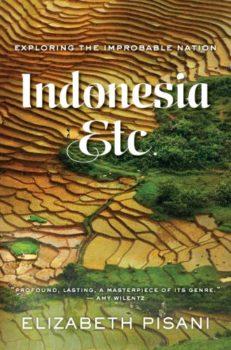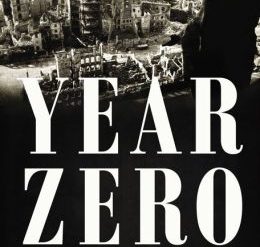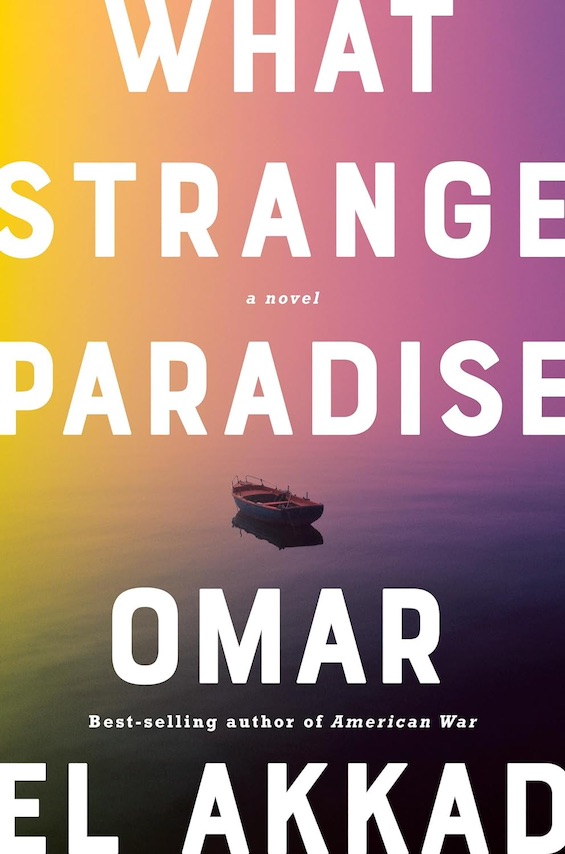
If you’re like most Americans, chances are you know little or nothing about Indonesia. Yet that island nation is the world’s fourth largest by population (after China, India, and the USA) and fifteenth largest by land area (just after Mexico). It also is home to the world’s largest population of Muslims. Indonesia consists of “a string of 13,466 islands inhabited by people from over 360 ethnic groups, who between them speak 719 languages.” If armchair exploring appeals to you, then you’ll love Indonesia Etc., Elizabeth Pisani‘s memoir of her 13-month journey through what she terms “the improbable nation.”
No run-of-the-mill travel writer
Pisani is no run-of-the-mill travel writer. She lived in Indonesia for three years as a reporter for Reuters (1988-91) and returned for another four-year stay a decade later after training as an epidemiologist specializing in AIDS. (Today, Pisani runs a public-health consultancy in London.) It’s clear from context in the book that she is fluent and comfortable in the lingua franca of the islands, Indonesian. Equally important, Pisani is one tough lady. Even as a youngster, I wouldn’t have dreamed of subjecting myself to the rigors of her 13-month odyssey.
Indonesia Etc.: Exploring the Improbable Nation by Elizabeth Pisani (2014) 427 pages ★★★★★
Colorful and engaging anecdotes
Indonesia Etc. is full of colorful and engaging anecdotes of the sort that will be familiar to anyone who has traveled extensively in the Third World. There is, for example, a hilarious tale of a Crocodile Whisperer, a shaman who presented himself as able to persuade the crocodiles in one region to identify and shun the one beast in their midst that had eaten a local woman. In other tales, Pisani recounts her experiences wearing the wrong batik design to the coronation of a local sultan and with a Koran-reading contest. “Koran-reading contests are as popular in Indonesia as visits by Manchester United’s touring team.”
Then there was her effort to travel from small island to another. “‘Is there a schedule for the boat to Lonthor?’ I yelled across to the boatmen. ‘Of course!’ they yelled back. ‘When do you leave?’ I bellowed. ‘When the boat is full!’ came the reply.”
Pisani emphasizes again and again the warm hospitality and sense of humor she encountered everywhere in Indonesia. After casual meetings on boats or buses, local people unhesitatingly invited her to live with them in their homes and share their food for days on end. Just imagine that happening in New York or Los Angeles!
Indonesia’s blood-soaked history
In Indonesia Etc., Pisani delves deeply into the history, politics, and economics of Indonesia. Amid her tales of days spent in tiny settlements or on leaky, slow-moving boats from island to island, she explores the history of this extraordinarily diverse and rich nation. Most of the time since the country gained independence from the Dutch in 1945 Indonesia has been dominated by two men whose legacies remain evident to the present day: Sukarno (1945-67) and Suharto (1968-98). Pisani recounts their years with rich detail about the tumultuous times during which they presided over the nation.
One event stands out: the massacre that brought Suharto to power. In the course of three years, at least half a million, and as many as three million Communists, ethnic Chinese, and alleged leftists were brutally murdered. Hundreds of thousands more were raped, driven from their homes, or saw their businesses destroyed.
As Pisani writes, “The carnage wiped out a whole generation of socially committed activists and pulled up the roots from which they might regrow. It crippled the development of political debate and made Indonesian citizens wary of political allegiance.” For decades afterward, the Indonesian military ran rampant through the breakaway provinces of East Timor and Aceh as well as other regions that sought independence for themselves.
Indonesia today: one of the world’s most decentralized nations
From Pisani’s perspective, Sukarno and Suharto followed radically divergent political paths. Sukarno moved to centralize government, imposing rigid control from the country’s most populous island (Java) on the rest of the country and launching a satellite to carry news in the Indonesian language throughout the archipelago. Suharto initiated decentralization, devolving power onto local government.
“At a stroke,” Pisani writes, “the world’s fourth most populous nation and one of its most centralized burst apart to become one of its most decentralized. The centre still takes care of defence, fiscal policy, foreign relations, religious affairs, justice and planning. But everything else—health, education, investment policy, fisheries and a whole lot more—was handed over to close to 300 district ‘governments,’ whose only experience of governing had, until then, been to follow orders from Jakarta.”
In myriad ways, Pisani shows how the move to decentralization has been a disaster for Indonesia. When she wrote her book in 2012, the number of district governments had grown to 509, virtually every one of them a fiefdom for the local elite and rife with corruption. (“‘Papua’s wealth used to be stolen by Jakarta. Now it’s stolen by the Papuan elite.'”) Yet, as Pisani takes pains to point out, “No other nation has welded so much difference together into so generally peaceable a whole in the space of less than seventy years.”
Indonesia’s endemic corruption
As the author explains, “A small fraction of jobs in the bureaucracy are awarded based on competitive exams. But most of the jobs that are not given out to political supporters get sold . . . The minister in charge of the ‘state apparatus’ recently said that 95 percent of Indonesia’s 4.7 million civil servants didn’t have the skills they needed to do their jobs.” Many Indonesians attribute their country’s endemic corruption to the legacy of Dutch colonialism. Compared to the English, the Dutch provided few educational opportunities for their subjects. However, Indonesia has been independent for seven decades. Blaming colonialism is a bit of a stretch.
An “improbable nation?”
Pisani subtitles her book Exploring the Improbable Nation. She makes clear that Indonesia’s unmatched diversity, island geography, and complex history could well have resulted in many different countries rather than one. There’s no disputing this. However, to a somewhat lesser degree, the same might be said of many of the European countries that are generally regarded as the most stable and logical nation-states in the world: Italy, Germany, France, Spain, even England. Dig beneath the surface in any one of these countries, and you’ll find the nation-building that occurred in centuries past was anything but an inevitable outcome. All these countries are rife with regional differences in culture, history, and even language. To be sure, the regional differences are by no means as stark as they are in Indonesia, but it would be a mistake to assume that the emergence of these countries as unitary political units was foreordained.
For related reading
Clearly, Indonesia’s geography is a decisive factor in setting its course in the world. For insight about how geography determines destiny, see my review of Prisoners of Geography: Ten Maps That Explain Everything About the World by Tim Marshall (A thought-provoking look at geopolitics) and The Revenge of Geography: What the Map Tells Us About Coming Conflicts and the Battle Against Fate by Robert D. Kaplan (From Robert D. Kaplan, a thought-provoking view of world politics).
You might also enjoy Great biographies I’ve reviewed: my 10 favorites.
This book is one of Two dozen excellent memoirs.
And you can always find my most popular reviews, and the most recent ones, on the Home Page.



























